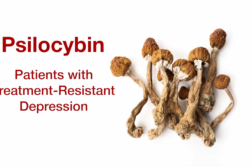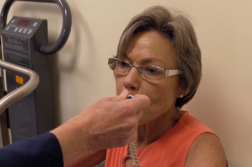BUFFALO, N.Y. (Ivanhoe Newswire) — Dreams and visions of the dying have been well-documented throughout history and across cultures. They often give patients comfort as they approach death. But they’ve never been studied scientifically … until now.
“Another time she’s coming outside in her flowered dress with her apron on,” detailed Geraldine Musser, a hospice patient.
Musser is talking about the dream she had about her mother, who died many years ago.
Musser told Ivanhoe, “It means she’s out there. When I die I’ll see her again.”
Hospice buffalo is working on a groundbreaking research study on dreams and visions of the dying.
“I was taking care of patients all of a sudden who were all dying and I was witnessing something that I neither been trained to understand or knew how to interpret,” said Christopher Kerr, MD, PhD, the Chief Medical Officer at Hospice Buffalo in Buffalo, New York.
Dr. Kerr began a study in 2011 with 66 patients. They now have thirteen hundred reported incidents in several follow-up studies.
“I thought it was very important to legitimize these patients, to quantify it, to put it in a context that doctors would understand,” explained Dr. Kerr.
Researchers ask patients very specific questions about their dreams and record the answers.
Clinical researcher, Rachel Depner, told Ivanhoe the questions they would ask included, “What was this like for you? Does this remind you of anything? Does this affect your sense of meaning or purpose in life, your attitudes about death and dying?“
The first study results were published in the Journal of Palliative Medicine. It turns out these dreams and visions are comforting and profoundly meaningful to those dying.
“This idea of love and forgiveness seem to be an overarching theme that make people whole again as they’re approaching death,” said Dr. Kerr.
Musser said, “It makes you feel better knowing they’re there.”
Further research is ongoing at Hospice Buffalo involving hundreds of patients, and researchers are currently analyzing more than 550 dreams. For more information, visit www.hospicebuffalo.com.
Contributors to this news report include: Kris O’Donnell, Producer; Tom Vetter, Photographer; Jamie Koczan, Editor.
Free weekly e-mail on Medical Breakthroughs from Ivanhoe. To sign up: http://www.ivanhoe.com/ftk
DREAMS OF THE DYING
REPORT #2493
BACKGROUND: One-third of your life is spent sleeping. A person, on average, will spend a total of about six years of it dreaming. Most healthy people have dreams. However, there are some people who don’t believe they dream at night when, in fact, they just don’t remember. A lack of dream activity may imply some protein deficiency or a personality disorder. You can dream anywhere from one to two hours every night, and you can have anywhere from four to seven dreams in one night. Vision is not the only sense that constitutes a dream. Sound, tactility, and smell become hypersensitive and dreams can be based on these senses. Five minutes after the end of the dream, half the content is forgotten. After ten minutes, 90 percent is lost. Studies have shown that your brain waves are more active when you are dreaming than when you are awake. Dreamers who are awakened right after REM sleep are able to recall their dreams more vividly than those who slept through the night until morning. Fear and anxiety are the most commonly expressed emotions in dreams, followed by anger and sadness.
(Source: http://www.dreammoods.com/dreaminformation/dreamfacts.htm)
DREAMING AND VISIONS: Many in hospice suffer from delirium, which can affect up to 85 percent of hospitalized patients at the end of life. In a delirious state, brought on by fever, brain metastases or end-stage changes in body chemistry, the patient may not know whether they are awake or dreaming. Their cognition is altered. Those who care for the terminally ill are inclined to see end-of-life dreams as manifestations of delirium. However, Hospice Buffalo researchers say that while some study patients slipped in and out of delirium, their end-of-life dreams were not, by definition, the product of such a state. Delirious patients generally cannot engage with others or give a coherent, organized narrative. The hallucinations they are able to describe may be traumatizing, not comforting. Yet the question remains of what to make of these patients’ claims of “dreaming” or having “visions” and the not-uncommon phenomena of seeing deceased relatives or friends hovering on the ceiling or in corners.
(Source: https://www.nytimes.com/2016/02/02/health/dreams-dying-deathbed-interpretation-delirium.html)
CURRENT RESEARCH BRINGS COMFORT: A recent study in the Journal of Palliative Medicine by Associate Professor James P. Donnelly, PhD, and colleagues found that end-of-life dreams and visions (ELDV) are a comforting part of the dying process. “These dreams and visions may improve quality of life and should be treated accordingly,” says Donnelly, associate professor of counseling and human services, and director of measurement & statistics for the Institute of Autism Research at Canisius College. This is the first study to interview patients about their ELDV experiences in the last weeks of life. Previous studies were limited to retrospective information from clinicians or family members. The researchers found that the most common dreams and visions were of deceased relatives or friends. Dreams and visions about the deceased were “significantly more comforting” to patients than other kinds of ELDVs, and became more frequent as the person approached death. Some medical professionals tend to discount pre-death dreams and visions as delusions or hallucinations and treat them as problems. The study concluded, “During a delirium state, the person has lost their connection to reality and ability to communicate rationally. Delirium is distressing and dangerous, and must be treated medically. In contrast, the study shows that ELDVs are typically comforting, realistic, and often very meaningful, highlighting a critical difference,” explained Donnelly.
(Source: https://www.sciencedaily.com/releases/2015/10/151020145757.htm)
* For More Information, Contact:
Clarice Otminski
Director of PR & Community Marketing
716-989-2072



